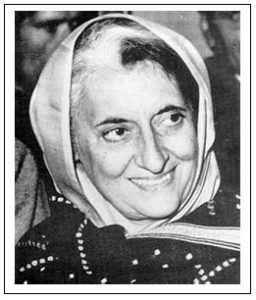Indira Gandhi (1917-1984) was the only child of Kamla and Jawaharlal Nehru. She spent part of her childhood in Allahabad, where the Nehrus had their family residence, and part in Switzerland, where her mother Kamla convalesced from her periodic illnesses. She received her college education at Somerville College, Oxford. A famous photograph from her childhood shows her sitting by the bedside of Mahatma Gandhi, as he recovered from one of his fasts; and though she was not actively involved in the freedom struggle, she came to know the entire Indian political leadership. After India’s attainment of independence, and the ascendancy of Jawaharlal Nehru, now a widower, to the office of the Prime Minister, Indira Gandhi managed the official residence of her father, and accompanied him on his numerous foreign trips. She had been married in 1942 to Feroze Gandhi, who rose to some eminence as a parliamentarian and politician of integrity but found himself disliked by his more famous father-in-law, but Feroze died in 1960 before he could consolidate his own political forces.
In 1964, the year of her father’s death, Indira Gandhi was for the first time elected to Parliament, and she was Minister of Information and Broadcasting in the government of Lal Bahadur Shastri, who died unexpectedly of a heart attack less than two years after assuming office. The numerous contenders for the position of the Prime Ministership, unable to agree among themselves, picked Indira Gandhi as a compromise candidate, and each thought that she would be easily manipulable. But Indira Gandhi showed extraordinary political skills and tenacity and elbowed the Congress dons — Kamaraj, Morarji Desai, and others — out of power. She held the office of the Prime Minister from 1966 to 1977. She was riding the crest of popularity after India’s triumph in the war of 1971 against Pakistan, and the explosion of a nuclear device in 1974 helped to enhance her reputation among middle-class Indians as a tough and shrewd political leader. However, by 1973, Delhi and north India were rocked by demonstrations angry at high inflation, the poor state of the economy, rampant corruption, and the poor standards of living. In June 1975, the High Court of Allahabad found her guilty of using illegal practices during the last election campaign, and ordered her to vacate her seat. There were demands for her resignation.
Mrs. Gandhi’s response was to declare a state of emergency, under which her political foes were imprisoned, constitutional rights abrogated, and the press placed under strict censorship. Meanwhile, the younger of her two sons, Sanjay Gandhi, started to run the country as though it were his personal fiefdom, and earned the fierce hatred of many whom his policies had victimized. He ordered the removal of slum dwellings, and in an attempt to curb India’s growing population, initiated a highly resented program of forced sterilization. In early 1977, confident that she had debilitated her opposition, Mrs. Gandhi called for fresh elections, and found herself trounced by a newly formed coalition of several political parties. Her Congress party lost badly at the polls. Many declared that she was a spent force; but, three years later, she was to return as Prime Minister of India. The same year, however, her son Sanjay was killed in an airplane crash.
In the second, post-Emergency, period of her Prime Ministership, Indira Gandhi was preoccupied by efforts to resolve the political problems in the state of Punjab. In her attempt to crush the secessionist movement of Sikh militants, led by Jarnail Singh Bindranwale, she ordered an assault upon the holiest Sikh shrine in Amritsar, called the “Golden Temple”. It is here that Bindranwale and his armed supporters had holed up, and it is from the Golden Temple that they waged their campaign of terrorism not merely against the Government, but against moderate Sikhs and Hindus. “Operation Bluestar”, waged in June 1984, led to the death of Bindranwale, and the Golden Temple was stripped clean of Sikh terrorists; however, the Golden Temple was damaged, and Mrs. Gandhi earned the undying hatred of Sikhs who bitterly resented the desacralization of their sacred space. In November of the same year, Mrs. Gandhi was assassinated, at her residence, by two of her own Sikh bodyguards, who claimed to be avenging the insult heaped upon the Sikh nation.
Mrs. Gandhi acquired a formidable international reputation as a “statesman”, and there is no doubt that she was extraordinarily skilled in politics. She was prone, like many other politicians, to thrive on slogans, and one — Garibi Hatao, “Remove Poverty” — became the rallying cry for one of her election campaigns. She had an authoritarian streak, and though a cultured woman, rarely tolerated dissent; and she did, in many respects, irreparable harm to Indian democracy. Apart from her infamous imposition of the internal emergency, the use of the army to resolve internal disputes greatly increased in her time; and she encouraged a culture of sycophancy and nepotism. At her death, her older son, Rajiv Gandhi, was sworn in as head of the Congress party and Prime Minister.
For a Ukrainian translation of this page by Olena Chervona, go to: https://all-guides.com/publicetions/indira-gandi.html.
For a Croatian translation of this page by Milica Novak, go to: http://pro4education.com/indira-gandhi/
For an Estonian translation of this page by Martin Aus, go to: http://techglobaleducation.com/indira-gandhi/


